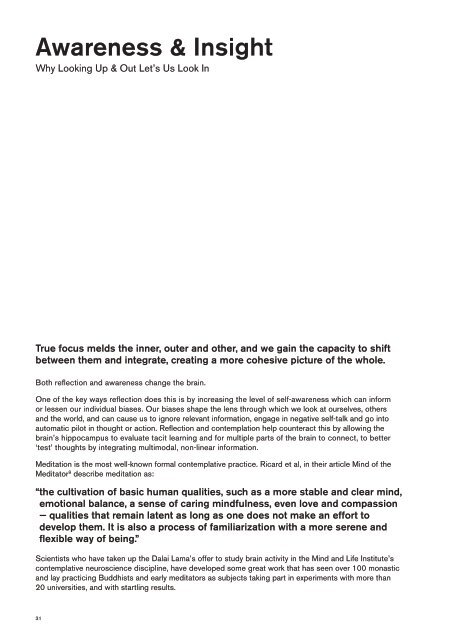THE ART AND SCIENCE OF LOOKING UP REPORT
You also want an ePaper? Increase the reach of your titles
YUMPU automatically turns print PDFs into web optimized ePapers that Google loves.
Awareness & Insight<br />
Why Looking Up & Out Let’s Us Look In<br />
Study 1.0<br />
The study compared veteran versus novice meditators, and allowed researchers to watch through<br />
neuroimaging what happens during three major forms of Buddhist meditation.<br />
True focus melds the inner, outer and other, and we gain the capacity to shift<br />
between them and integrate, creating a more cohesive picture of the whole.<br />
Both reflection and awareness change the brain.<br />
One of the key ways reflection does this is by increasing the level of self-awareness which can inform<br />
or lessen our individual biases. Our biases shape the lens through which we look at ourselves, others<br />
and the world, and can cause us to ignore relevant information, engage in negative self-talk and go into<br />
automatic pilot in thought or action. Reflection and contemplation help counteract this by allowing the<br />
brain’s hippocampus to evaluate tacit learning and for multiple parts of the brain to connect, to better<br />
‘test’ thoughts by integrating multimodal, non-linear information.<br />
Meditation is the most well-known formal contemplative practice. Ricard et al, in their article Mind of the<br />
Meditator 9 describe meditation as:<br />
“the cultivation of basic human qualities, such as a more stable and clear mind,<br />
emotional balance, a sense of caring mindfulness, even love and compassion<br />
— qualities that remain latent as long as one does not make an effort to<br />
develop them. It is also a process of familiarization with a more serene and<br />
flexible way of being.”<br />
Scientists who have taken up the Dalai Lama’s offer to study brain activity in the Mind and Life Institute’s<br />
contemplative neuroscience discipline, have developed some great work that has seen over 100 monastic<br />
and lay practicing Buddhists and early meditators as subjects taking part in experiments with more than<br />
20 universities, and with startling results.<br />
31<br />
Focused Attention<br />
aims to tame and centre the<br />
mind while remaining vigilant<br />
and present, allowing the<br />
meditator to minimise mind<br />
wandering, and refocus quickly<br />
if it occurs.<br />
The study showed different<br />
patterns of activity in the<br />
attention areas of the brain<br />
depending on the level of<br />
experience, with veteran<br />
meditators able to focus at will,<br />
with little effort.<br />
Mindfulness<br />
aims to improve attentiveness<br />
but lower emotional reactivity<br />
to internal emotions, thoughts<br />
and sensations.<br />
With practice, meditators<br />
increased their ability to<br />
optimise attention but control<br />
and buffer physiological<br />
responses. Scientists observed<br />
such outcomes as moderating<br />
stress through lowering stress<br />
hormones, lowering pain<br />
and inflammation levels and<br />
depression, and improvement<br />
in a variety of activities including<br />
sleep, public speaking and<br />
maths calculations.<br />
Compassion & Loving Kindness<br />
fosters an altruistic perspective<br />
towards others, with an awareness<br />
of their needs and a sincere desire<br />
to help them.<br />
Two groups meditated on empathy,<br />
with one also including meditation<br />
on love and compassion. It was<br />
found that just increasing empathy<br />
can lead to empathy fatigue,<br />
but including the second allowed<br />
the meditator to step back and<br />
contemplate how to help, which<br />
strengthened several cognitive<br />
areas linked to determination and<br />
emotional resilience, decreasing<br />
distress and emotional overload.<br />
Over time this is seen as leading to<br />
benevolent wisdom.<br />
Amazingly, expert meditators could not only sustain a particular electrical brain pattern that allows temporary<br />
networks to be grown integrating cognitive and emotional functions during learning, but could then convert<br />
them into new brain circuitry.<br />
32















